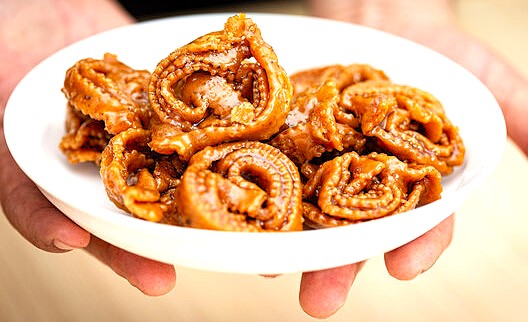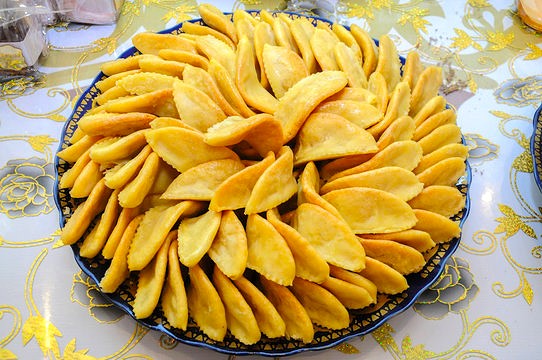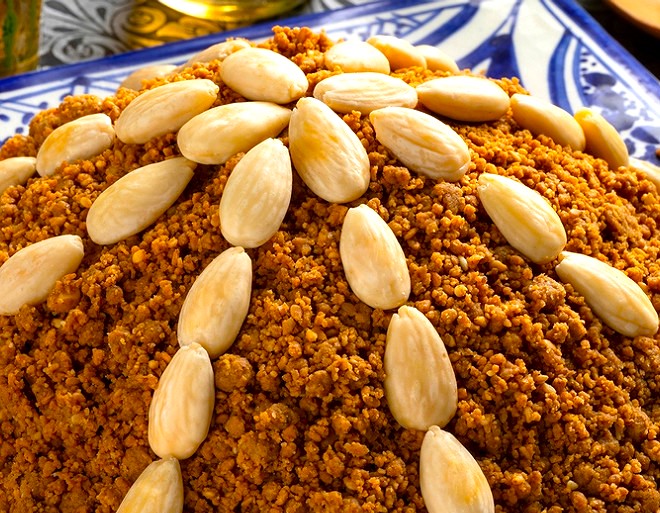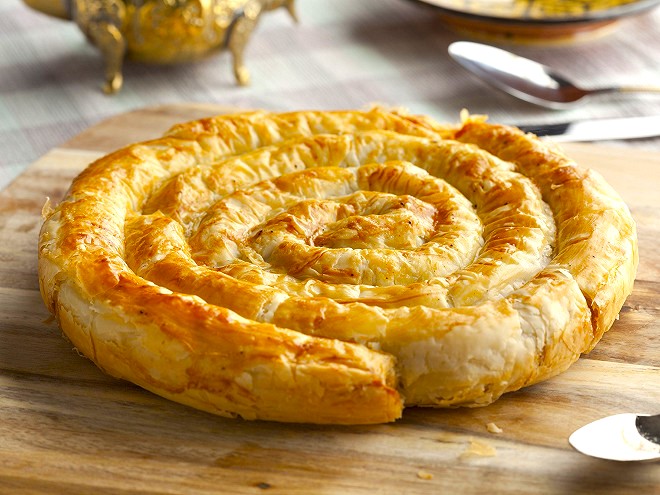Moroccan Sweets and Desserts: A Journey Through Flavors and Tradition
Moroccan sweets and desserts are more than just treats, they are a window into the country’s rich culture, history, and artistry. From honey-soaked pastries to almond-stuffed delights, Moroccan desserts showcase a perfect balance of sweetness, aroma, and texture.
Traditionally served during weddings, religious festivals, and family gatherings, these sweets symbolize hospitality, celebration, and Moroccan craftsmanship. Each dessert reflects centuries of Arab, Berber, and Andalusian influences, blending local ingredients like almonds, dates, orange blossom water, and sesame seeds into creations that are both visually stunning and delicious.
Popular Moroccan desserts include:
-
Chebakia: Honey-coated sesame cookies, often served during Ramadan.
-
Gazelle Horns (Kaab el Ghazal): Almond-filled crescent pastries flavored with orange blossom water.
-
Sellou (Sfouf): A rich, toasted almond and sesame mixture, commonly enjoyed during celebrations.
Experiencing Moroccan sweets is essential for travelers seeking an authentic taste of Morocco. Pairing them with Moroccan mint tea or savoring them after a Moroccan Tagine meal provides a complete cultural and culinary journey.
Want to discover more Moroccan flavors? Explore the Moroccan Tagine for a slow-cooked, aromatic experience that complements these sweets beautifully.
Ingredients and Traditional Techniques: Crafting Moroccan Sweets
Moroccan desserts are a celebration of natural ingredients and artisanal techniques, reflecting centuries of culinary artistry. The magic lies in the careful combination of flavors, textures, and presentation.
Core Ingredients
Moroccan sweets rely on almonds, dates, sesame seeds, honey, and orange blossom water as foundational ingredients. Almonds are often toasted and ground for pastries like Gazelle Horns (Kaab el Ghazal), while honey and sesame seeds form the sticky, aromatic base of Chebakia. Dates provide natural sweetness and are used in stuffed pastries or blended treats.
Flavors and Aromatics
Orange blossom water, cinnamon, anise, and rose water add fragrant complexity, creating the signature taste of Moroccan desserts. These aromatics are delicately balanced to enhance, rather than overpower, the natural sweetness of the ingredients.
Traditional Techniques
Moroccan desserts often require skilled handcrafting:
-
Rolling and shaping pastries like Gazelle Horns with precise folding and sealing.
-
Shaping Chebakia into intricate floral designs before frying and coating in honey.
-
Toasting and grinding almonds or sesame seeds to create pastes or crunchy toppings.
These techniques have been passed down through generations, often within families, and are a testament to Moroccan culinary heritage. Participating in Moroccan cooking classes allows travelers to learn these traditional skills firsthand, turning preparation into an immersive cultural experience.
Pairing Moroccan sweets with Moroccan mint tea or enjoying them after a Moroccan Tagine meal creates a full sensory journey, highlighting the balance of sweet, savory, and aromatic elements in Moroccan cuisine.
Exploring the Delicious Variations of Moroccan Sweets
Moroccan desserts are extraordinarily diverse and full of character, offering travelers and food enthusiasts a rich exploration of flavor, aroma, and tradition. Each variation reflects Morocco’s long culinary history, blending influences from Arab, Berber, and Andalusian cultures, while showcasing the country’s skillful use of local ingredients.
Chebakia: Honey and Sesame Delight
Chebakia is a deeply rooted Moroccan dessert, consisting of thinly rolled dough shaped into intricate floral patterns, deep-fried until golden, and generously coated with honey and sesame seeds. Traditionally prepared during Ramadan, Chebakia symbolizes abundance and sharing, often made in large batches with family members gathering to craft the perfect pieces together. Its sticky sweetness and delicate texture make it both a visual and culinary delight, leaving a lasting impression on anyone tasting it.

Gazelle Horns (Kaab el Ghazal): Almond-Filled Elegance
Gazelle Horns, or Kaab el Ghazal, are elegant crescent-shaped pastries filled with almond paste and flavored with orange blossom water and cinnamon. These treats are essential at Moroccan weddings and festive celebrations, symbolizing prosperity, joy, and hospitality. The process of shaping, filling, and baking these delicate pastries requires patience and precision, making them a true representation of Moroccan culinary artistry.

Sellou (Sfouf): Toasted Almond and Sesame Mix
Sellou, also known as Sfouf, is a nutty, energy-packed dessert made from toasted almonds, sesame seeds, flour, and spices. Its slightly crunchy texture and rich flavor make it perfect for festive occasions and long gatherings, reflecting the Moroccan tradition of creating nourishing, flavorful, and shareable sweets. Sellou is often served during religious festivals, and its preparation is considered a ritual that brings families together.

M’hancha: The Almond Snake Cake
M’hancha, or the almond “snake” cake, is a coiled pastry filled with sweet almond paste, cinnamon, and orange blossom water, creating a visually striking spiral. Traditionally served during celebrations, M’hancha is both a feast for the eyes and the palate, showcasing Morocco’s artistry in dessert-making. Its preparation involves careful rolling and coiling, highlighting the intricate techniques passed down through generations.

Pairing and experiencing moroccan desserts
These iconic sweets are best enjoyed with a cup of Moroccan mint tea or after a Moroccan Tagine meal. For travelers who want to experience Moroccan cuisine firsthand, participating in cooking classes and culinary tours provides an immersive journey into Moroccan flavors, techniques, and cultural traditions, allowing visitors to learn, taste, and create these traditional sweets themselves.
Discover the magic of Moroccan sweets!
Contact Holiday Morocco Tours to plan your immersive culinary adventure, from learning to prepare traditional desserts in local kitchens to exploring other iconic Moroccan dishes
Celebratory and Festive Significance of Moroccan Sweets
Moroccan sweets are deeply intertwined with cultural celebrations and family traditions, making them much more than just desserts. These treats play a central role in festivals, weddings, and religious holidays, reflecting Morocco’s values of hospitality, generosity, and community.
Ramadan and Chebakia
During Ramadan, Chebakia is a staple. These honey-coated, sesame-studded pastries are traditionally prepared in large batches, symbolizing abundance and sharing. Families gather to make Chebakia together, turning the process into a communal activity that strengthens bonds.
Weddings and Almond Pastries
For weddings and special celebrations, almond-filled pastries like Gazelle Horns (Kaab el Ghazal) are commonly served. These delicacies represent prosperity, fertility, and sweetness in life, and are often prepared with care and artistry to impress guests.
Religious Festivals and Sellou
Sellou (Sfouf), a toasted mixture of almonds, sesame seeds, and flour, is commonly served during religious festivals. Its nutty richness and energy-packed ingredients make it ideal for long gatherings and festive occasions.
Hospitality and Daily Rituals
Even outside festivals, Moroccan sweets are offered to guests alongside Moroccan mint tea, symbolizing warmth, respect, and welcome. Offering sweets is a cultural gesture that reflects Morocco’s deep-rooted tradition of hospitality.
Travelers eager to explore Morocco’s culinary heritage can experience these sweets firsthand during cooking classes or food tours, learning the techniques and traditions behind each dessert. Pairing these sweets with a Moroccan Tagine or mint tea creates a complete Moroccan tasting journey.
Experience Moroccan Sweets: A Taste of Tradition and Celebration
Moroccan sweets are more than just desserts; they are a celebration of culture, craftsmanship, and hospitality. From the honey-soaked Chebakia to the delicately coiled M’hancha, each treat tells a story of tradition, family, and festive joy. Enjoying these sweets provides travelers with a unique window into Morocco’s culinary heritage, highlighting the artistry, flavors, and rituals that define Moroccan life.
Bring the sweet flavors of Morocco to your journey. Contact Holiday Morocco Tours to plan your immersive culinary adventure, from learning to prepare traditional desserts in local kitchens to exploring other iconic Moroccan dishes like the Moroccan Tagine. Taste, learn, and savor the authentic flavors and traditions of Morocco for an unforgettable travel experience.
